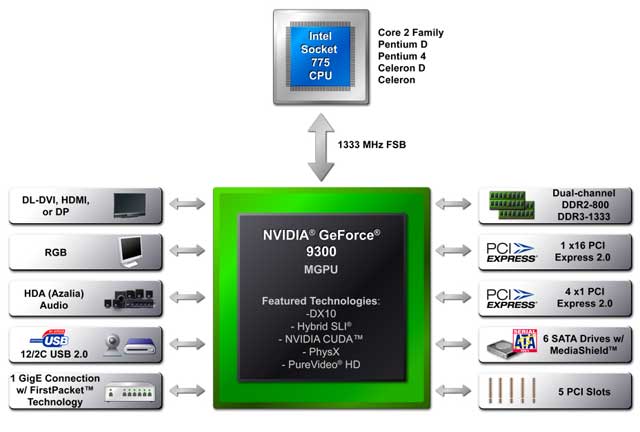2 - Meet the NVIDIA MCP7A chipset
So as stated, NVIDIA will release two motherboard integrated chipset products today, two mainboard chipsets. Both chipsets virtually being the same except for the GPU clocks. These mainboards use the integrated chipset NVIDIA GF9300, but it boils down to what you have learned from the name nForce 730i, which on its end is the architecture as used in the MCP7A chipset.
The MCP7A silicon supports all series of Intel Quad/Dual/Single Core processors with an FSB up to 1333 MHz. It comes integrated with GeForce 9300 graphics, supports DDR2 dual channel memory and PCIe 2.0 x16 slot. The boards come with SATA2, 7.1, HDA audio (Azalia), GBit Ethernet, VGA+DVI+HDMI output and so on.
This chipset itself has been discussed ever since... oh eh... April? So it arrives on the scene a little later than planned, especially with Core i7 processors right around the corner. So bear in mind, this Intel compatible chipset supports up to 1,333 MHz FSB and Intel Core 2 CPUs, but not Bloomfield/Nehalem/i7 socket 1366 CPUs.
It supports every socket 775 processor except 1,600 MHz FSB CPUs, we clear on that? Good :) I do not think you'd insert a 1300 USD QX9770 processor on this mainboard anyway.
As stated, the basis of this mainboard chipset is the MCP7A, which in fact is an nForce family based product, highly integrated with some admittedly great features, yet marketed as a Series 9 mainboard product. Let's have a look at the block diagram to understand what this single chipset solution offers:

So the first thing that haunts our eyes is obviously the integrated GPU. It's actually DX10 compatible, though I dare you to play a DX10 title on it... wouldn't that be something, "I'm playing Crysis DX10 on this integrated GPU you biaches," hehe, no way.
But for an integrated solution it's interesting. It comes with 16 shader cores. By itself not exactly a power house... but some older titles are playable. The core runs at 450 MHz for the 9300 Model and it's 16 shader cores at 1200 MHz.
So why is this integrated GPU interesting you might wonder. Well, for a multitude of reasons ... say you want to build a home theater PC which needs to decode Blu-ray(VC-1, H.264, MPEG-2) movies; you can use the integrated GPU for Purevideo HD. And it's really good at it as well. For example, I hooked up my HD-DVD (Yeah I know... money well spend right?) and then we quality tested with HQV-HD. We got a a perfect score (128) returned. Meaning, the integrated GPU can not only decode HD bit streams, but also accelerate and enhance the content. This a very big plus and downright interesting for HTPC users as literally, mainboards like these only require some memory, PSU, HDD, chassis and a processor. And then you are good to go. Speaking of HTPCs, these motherboards can come with Display Port connector, HDMI (HDCP), DVI... and the good news here... they are dual-link DVI, and thus support high-resolution screens. Very nice. Connectivity obviously differs per manufacturer.
Another less exciting GPU feature is hybrid graphics, something as far as I'm concerned NVIDIA can stop developing at this performance level. The overall performance of the GPU in modern games is poor, really. Now you can match up the IGP (GeForce 9300) with a similar dedicated card to increase performance. The result... still a solution which is slow. My bet is that you'll end up buying a faster dedicated graphics adapter anyway, so the entire hybrid SLI thing then is just not doing it for me personally, I feel it's like riding a bike with two flat tires.
Now the 'what if' - what if you use this mainboard with let's say a GeForce 9800 GTX+, here's the candy... CUDA pops up every time we see an NVIDIA GPU. Though not record breaking, you can use the integrated graphics solution for transcoding video, Folding@Home, but even better... you can enhance your gaming experience as here is the deal maker... the integrated graphics unit can be put to work as a PhysX processor. So you are happily rendering your game with a GeForce 9800 GTX+ and then the integrated IGP can manage PhysX. You didn't think of that one did ya? By itself the IGP is decent enough for this function.
When we look closer at the block diagram we notice some more interesting features. 7.1 Channel HDA sound, the motherboard GPU offers full 8-channel LPCM uncompressed audio streams to drive 7.1 surround sound home theater systems comprised of right, left, center, left surround, left rear, right surround, right rear, and LFE/subwoofer channels.
Also none too shabby, 12x USB 2.0 (supported), DDR2-800 MHz support. For dedicated graphics we spot a full x16 lanes PCI-Express bus, and next to that luxurious support for 4 times 1x PCIe and, optional per mainboard manufacturer support, up to 5 PCI slots which are still very much preferred by you guys. Also 6x SATA are supported and obviously a PATA (IDE) slot for your somewhat older optical devices and HDDs.
Anyway, talk is cheap... on the next page a full feature set, after which we'll go into a photo-shoot covering all the ins and outs of the ECS Elitegroup GF9300T-A mainboard we are testing today. And face the facts here .. for a ~100 USD mainboard, that piece of silicon is looking good.

